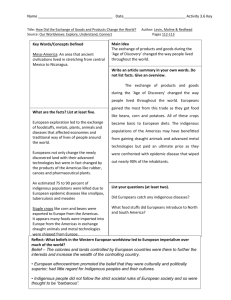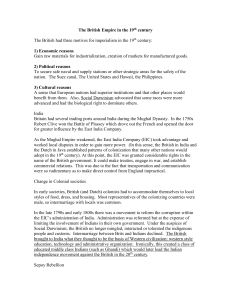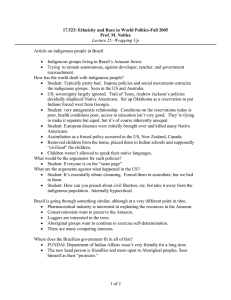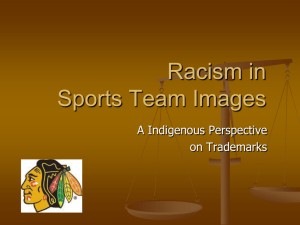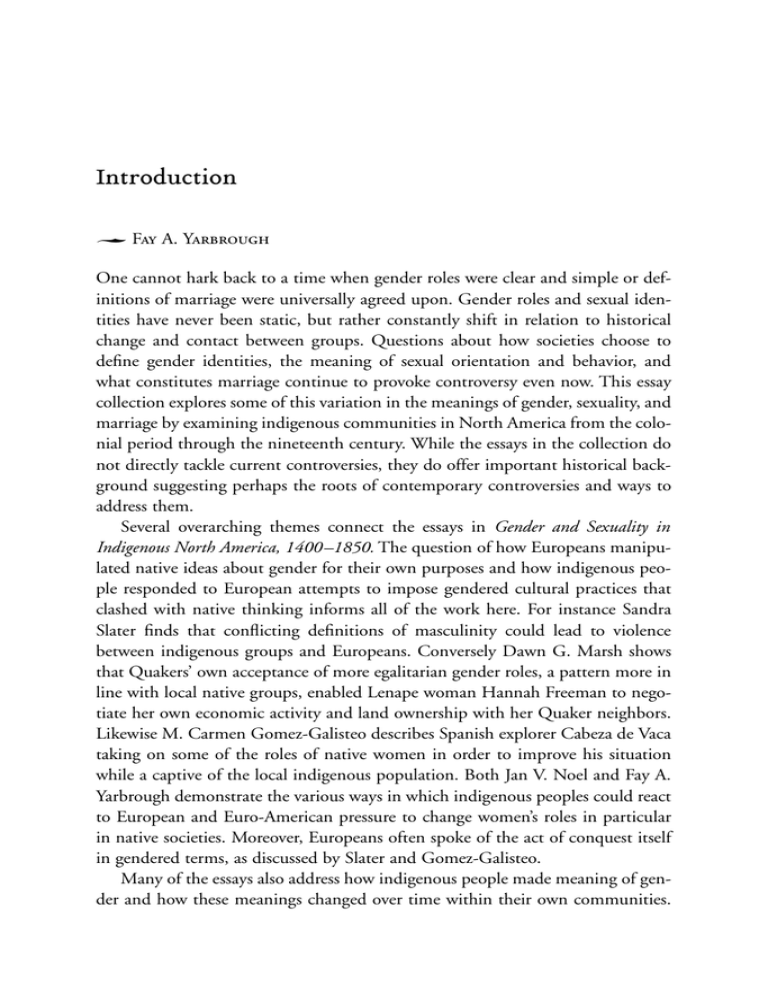
Introduction
Fay A. Yarbrough
One cannot hark back to a time when gender roles were clear and simple or definitions of marriage were universally agreed upon. Gender roles and sexual identities have never been static, but rather constantly shift in relation to historical
change and contact between groups. Questions about how societies choose to
define gender identities, the meaning of sexual orientation and behavior, and
what constitutes marriage continue to provoke controversy even now. This essay
collection explores some of this variation in the meanings of gender, sexuality, and
marriage by examining indigenous communities in North America from the colonial period through the nineteenth century. While the essays in the collection do
not directly tackle current controversies, they do offer important historical background suggesting perhaps the roots of contemporary controversies and ways to
address them.
Several overarching themes connect the essays in Gender and Sexuality in
Indigenous North America, 1400–1850. The question of how Europeans manipulated native ideas about gender for their own purposes and how indigenous people responded to European attempts to impose gendered cultural practices that
clashed with native thinking informs all of the work here. For instance Sandra
Slater finds that conflicting definitions of masculinity could lead to violence
between indigenous groups and Europeans. Conversely Dawn G. Marsh shows
that Quakers’ own acceptance of more egalitarian gender roles, a pattern more in
line with local native groups, enabled Lenape woman Hannah Freeman to negotiate her own economic activity and land ownership with her Quaker neighbors.
Likewise M. Carmen Gomez-Galisteo describes Spanish explorer Cabeza de Vaca
taking on some of the roles of native women in order to improve his situation
while a captive of the local indigenous population. Both Jan V. Noel and Fay A.
Yarbrough demonstrate the various ways in which indigenous peoples could react
to European and Euro-American pressure to change women’s roles in particular
in native societies. Moreover, Europeans often spoke of the act of conquest itself
in gendered terms, as discussed by Slater and Gomez-Galisteo.
Many of the essays also address how indigenous people made meaning of gender and how these meanings changed over time within their own communities.
Fay A. Yarbrough
Noel describes Iroquois women’s position before European contact as quite powerful and integral to the social, economic, and political life of the Iroquois people.
Marsh and Yarbrough also show that some elements of native women’s authority
endured despite, and sometimes because of, contact with colonists and Americans. Roger M. Carpenter’s essay demonstrates the variety of possible gender roles
among some indigenous groups in his description of the two-spirit phenomenon,
a topic also dealt with in varying degrees by Gomez-Galisteo, Slater, and Gabriel S.
Estrada.
Several authors consider sexual practice as a site for cultural articulation, as
well as a vehicle for the expression of gender roles. Estrada, for instance, contends
that many contemporary writers employ indigenous sexual and gender histories
in describing their own contemporary racial, ethnic, and sexual identities, connecting sixteenth-century indigenous sexual practice and behavior to modern
Chicano/a and Mestizo/a authors and identities. Estrada’s work forms a provocative conversation with Gomez-Galisteo, Slater, and Carpenter about the roles,
function, and perception of two-spirited individuals in native societies, a conversation that addresses questions such as the ability of such individuals to marry or
participate in warfare and ceremonial life, and choice and consent in taking on
this role. Conversely Gomez-Galisteo also notes the surprising absence of sexual
activity between native women and European men in Cabeza de Vaca’s narrative,
an omission that runs counter to many other accounts by Cabeza de Vaca’s contemporaries and that may have had political implications of its own.
Finally, race is an important lens through which many of the authors here
examine native history, and thus race is another theme linking the essays in this
collection. Often Europeans and colonists viewed native practices, be they related
to gender, sexual activity, religion, and so forth, as suspect precisely because the
practitioners were a racialized “other” group. That is, allegedly promiscuous native
women described by Gomez-Galisteo, or so-called deviant sexual behavior discussed by Carpenter or Estrada, or barbarous practices in warfare presented by
Slater and Carpenter merely served as evidence of how different native people
were from European observers. Thus Salvadora de los Santos Ramirez, according
to Dorothy Tanck de Estrada, became the subject of religious interest because she
was an Otomi Indian and yet behaved in such a pious manner in spite of that
identity, exceeding even many European women in the colony in virtuous comportment. And sometimes natives began to formulate their own ideas about race,
as Yarbrough’s discussion of resistance and accommodation to American gender
roles among the Choctaw Indians demonstrates.
Gender and Sexuality in Indigenous North America, 1400–1850, bridges geographical divides with essays that focus on indigenous peoples in locations ranging
2
Introduction
from Canada, the expanse of the continental United States, and Mexico. Often
the contemporary boundaries separating these places are artificial and obscure the
fluidity of the societies that historically occupied these spaces. And indigenous
communities across these geographical territories sometimes shared similar experiences with colonialism and conquest. Scholarship on the borderlands, such as
James F. Brooks’s Captives and Cousins, demonstrates that the people living in
these spaces often did not recognize the legal borders that separated them. And
other essay collections, such as Tiya Miles and Sharon P. Holland’s Crossing Waters,
Crossing Worlds, which explores indigenous interactions with people of African
descent from New England to the Indian Territory, also confirm the value of looking beyond traditional regional boundaries.1
Authors had been producing materials considering native populations for
quite some time, as early as the eighteenth century, before the recent turn by
scholars to discussions of this aspect, gender and sexuality, of the meeting of
indigenous peoples and Europeans.2 In the interim of the nineteenth century,
other writers provided useful histories of various native groups or events.3 By the
twentieth century native groups had become the focus of intense study for
anthropologists.4 At the same time figures such as Grant Foreman and Angie
Debo were producing comprehensive histories of various North American indigenous groups while Annie Heloise Abel wrote detailed studies of American Indians
confronting the American Civil War.5 In the latter twentieth century the larger
field of American Indian Studies grew, in part, out of the agitation of American
Indian students who participated in the activist movements of the Civil Rights
Era. Such agitation led to the growth of Native American Studies departments
and programs at American universities and to a proliferation in the production of
histories of native peoples. Scholars attempted to illuminate native life and reveal
native perspectives on interactions with Europeans and later Americans. These
students and scholars demonstrated that Indians had not, in fact, “vanished,” and
that a process sometimes seen as the conquest and absorption of native groups by
European forces was far more complex and contested.6 And both “natives and
newcomers,” to borrow James Axtell’s phrase, changed in these interactions.7
Newer scholarship increasingly placed natives and their agency at the center
of the narrative.8 Academic histories of natives no longer began and ended
with European contact. Instead, anthropologists, archaeologists, and historians
plumbed new sources or considered more familiar sources in new ways to describe
varied and complex native societies with mature systems of governance that sometimes came into conflict long before the arrival of Europeans.9 Some indigenous
societies established extensive networks of trade and built cities.10 And some
native groups practiced a form of slavery, enslaving indigenous enemies and then,
3
Fay A. Yarbrough
later, people of African descent.11 Scholars depicted native peoples not as objects
of study but as historical subjects, acting and reacting to circumstances and making choices.
The field of American Indian history continues to be vibrant, as scholars ask
questions that complicate notions of resistance and the meaning of cultural continuity.12 Subjects of recent scholarship include the concept of native agency,
native pursuits of nationalism and national identities, relationships between
indigenous peoples and people of African descent, the fight for sovereignty in
indigenous communities, and the environmental consequences of federal policies
for American Indians.13 Moreover, many native groups grapple with the meaning
of Indian identity writ large in the United States given the role of the federal
government and the states in recognizing various Indian nations and within a
larger global context that includes indigenous peoples such as the Maori of New
Zealand or the Aborigines of Australia.14
This collection of essays captures the growing scholarly interest in the operation of notions of gender and sexuality in native societies throughout the colonial
Americas and through the Civil War era.15 Scholars posit questions such as, how
did gender roles for men and women in native societies change over time and in
relation to contact with Europeans? What ideas about gender remained constant
for particular indigenous communities and why? What was the role of native people who occupied seemingly incongruous places within gender paradigms? The
scholars’ answers to these questions reveal something of the meaning of gender in
native societies and for the Europeans who encountered them.
Organized chronologically, this collection begins with M. Carmen GomezGalisteo’s essay about the malleability of notions of gender among indigenous
groups and how outsiders could negotiate those ideas as a strategy for survival.
While in Spanish Florida, conquistador Cabeza de Vaca found himself in the
unlikely position of performing the duties of a native woman as a trader and a
healer in order to avoid the fate of many adult male captives, namely death.
Performing these duties also afforded Cabeza de Vaca freedom of movement and
more status than that of a slave. Rather than reject these roles because they were
too feminine, Cabeza de Vaca embraced them and wrote about them, not surprisingly, in a favorable light. Gomez-Galisteo also explores the gendered language
used by the conquistadors to describe the act of conquest and the physical land, as
well as the indigenous people they encountered. While many other explorers portrayed native women as monstrous and sexually aberrant in their promiscuity,
Cabeza de Vaca depicted native women as mothers and claimed to have been sexually chaste during his New World travels, a claim that Gomez-Galisteo questions.
Like Gomez-Galisteo, Sandra Slater addresses the meanings of masculinity
as they were negotiated by European explorers and natives in the early years of
4
Introduction
contact and what happened when those ideas sometimes collided. Slater posits
that both native and European men built their masculine identities on several
broad concepts: honor, their relationships to and with women, warfare, and sexual practice. European and native men might deem each other more or less manly
based on how each group treated women, behaved in battle, or permitted or punished certain kinds of sexual behavior. Moreover, in another point of tangency
with Gomez-Galisteo, Slater finds that the entire endeavor of exploration had
gendered connotations in European minds who described it in terms of the male
explorers displaying manly courage as they conquered the feminized “virgin” land.
And explorers sometimes extended this metaphor to the inhabitants of the land.
Thus, by conquering the land, European explorers imagined they had also conquered, and therefore had access to, native women. Slater’s essay underscores the
importance of masculinity in constructions and negotiations of identity in the
New World.
In a more synthetic exploration of gender roles within a specific native group,
Jan V. Noel provides a clear and thoughtful consideration of the existing literature
about gender among the Haudenosaunee (also known as the Iroquois) and argues
persuasively that the Haudenosaunee were not patriarchal. To the contrary, “the
Haudenosaunee, at least as late as the eighteenth century, saw male and female
roles in terms of reciprocal relationships that did not require power struggles.”
While this description of gender relationships is hard for many modern observers
to accept, Noel finds that women nonetheless performed important functions in
Haudenosaunee society by choosing leaders, by determining the fate of war captives, by adjudicating land disputes, by farming the land, and by participating in
council meetings. Contact with Europeans, of course, affected the relations
between the sexes in Iroquoia, but Noel finds that “there is considerable evidence
to suggest that many mature Iroquois women maintained unusual positions even
after two or three centuries of interaction with Europeans.” Noel contends the
Haudenosaunee offer a glimpse of the contours and possibilities of an egalitarian
society.
Dorothy Tanck de Estrada and Dawn Marsh consider the lives of individual
women and what their experiences can reveal about the larger societies from
which these women emerged. Tanck de Estrada describes the life of one remarkable native woman in eighteenth-century New Spain who was regarded by many
of her contemporaries as a saint. Salvadora de los Santos Ramirez’s rise to religious
importance was all the more surprising because of her status as an Otomi Indian,
“judged by many,” in Tanck de Estrada’s words, “to be the most backwards and
uncouth people in the region.” Perhaps even more unusual, shortly after her death
Father Antonio de Paredes, a prominent Jesuit priest, published her biography
in the form of an edifying letter, a form usually reserved for “recently deceased
5
Fay A. Yarbrough
priest[s], novice[s], or brother[s] who w[ere] thought to be exceptionally holy.”
Thus, while the sisters in the beaterio where de los Santos Ramirez lived and
worked did not appear to hold her in high regard, for reasons of class according
to Tanck de Estrada, the denizens of the city of Querétaro and at least one important member of the church hierarchy did. Through de los Santos Ramirez’s life,
Tanck de Estrada is able to illuminate gendered and cultural expectations about
women in colonial Mexico.
Just as Tanck de Estrada is able to access the life of a humble Otomi Indian
woman through the writings of a male contemporary, Marsh is able to recreate
the life of Hannah Freeman because a man, Moses Marshall, recorded the
details. In this case Marshall collected testimony about Freeman’s life for administrative purposes to determine her county of residence and eligibility for
the services of the poorhouse. Hannah Freeman’s life serves as a window on
native/colonial interactions in the eighteenth-century Pennsylvania colony.
Marsh finds that those relationships were often negotiated, and natives maintained a surprising amount of control over ancestral lands. Freeman, a Lenape
Indian, was a part of a mobile woman-centered family unit that followed the
demand for labor in the Brandywine River Valley and fled this territory in the
face of the brutality of the Paxton Boys, who massacred Conestoga Indians in
1763. Upon the family’s return from exile, Freeman continued to work as a basket maker, healer, seamstress, and servant for both black and white residents of
the valley. Marsh posits that Freeman, like her counterparts elsewhere, constantly strategized to preserve her connections to her traditional territories, and
that white people sometimes accommodated indigenous peoples in these claims
even when not bound by law to do so.
Fay A. Yarbrough exchanges the microhistorical approach of several of the
essays for a broader consideration of women’s roles in Choctaw society during the
nineteenth century and how those roles changed during this tumultuous time, a
century that included the removal of the Choctaw Indians from the southeastern
United States to Indian Territory in present-day Oklahoma and their alliance with
the Confederacy during the Civil War. She begins with a discussion of matrilineally determined clans and matrilocal households and their importance to
Choctaw social organization. Choctaw women also traditionally derived power
from their work as agriculturalists, producing the corn that was so important to
sustenance and ceremonial life among the Choctaws. Over the course of the nineteenth century, however, slaves of African descent, native men, and white men
would encroach on Choctaw women’s role as agriculturalists. And as Choctaws
turned to more formalized systems of governance in the form of a written constitution and laws, Choctaw women found some of their traditional authority eroding and their marital choices under increased scrutiny.
6
Introduction
While the three preceding articles focus on native women and men in more
familiar gendered roles, Roger M. Carpenter turns his attention to another gendered group that many, especially Europeans, found unfathomable. Carpenter
sheds important light on the role of male and female two-spirits in indigenous
society, particularly in warfare, and how they were perceived by native peoples and
Europeans. 16 Carpenter also offers some discussion of the origins and meaning
of the controversial term berdache. Found throughout much of Native North
America during the early contact period, two-spirit people provoked reactions
from European (and later American) explorers and missionaries ranging from
amusement to disgust to outright bafflement. Native groups appear to have
accepted two-spirit individuals of both sexes as participants in warfare, a conclusion buttressed by Slater’s assertion that two-spirit individuals often performed
important functions in battle as handlers of the bodies of dead warriors. Thus,
while the European colonists and their descendants found two-spirit individuals
particularly disturbing, native populations appeared to have a place for more than
two gender identities within their gender universe.
Finally, Gabriel S. Estrada’s deeply personal essay is part historiography and
part provocative consideration of how writers’ conclusions about indigenous sexual and gender histories are often shaped by their own racial, ethnic, and sexual
identities. Like Carpenter, Estrada discusses the contentious term berdache and
also the origins of the term two-spirit and why he prefers it. Moreover Estrada suggests that sixteenth-century indigenous sexual practice and behavior continue to
influence how modern Chicano/a and Mestizo/a authors see themselves. Many
authors find power in invoking an indigenous past or ancestry, but Estrada argues
that to do so without paying careful attention to the actual histories of the people one invokes or to the historical accuracy of the invocation is problematic.
Thus, for instance, different authors can examine indigenous histories of twospirit peoples and find degradation and oppression or celebration and adulation
or invisibility.
In the end we hope this collection of essays offers a preview of some of the
newest scholarship in the field of native history. Trained in different disciplines in
various countries, the contributors here work in several languages, apply varied
methodologies, and use different sources, so the essays also serve as a lens through
which to consider scholarly inquiry. Moreover, the issues the authors discuss—
gender, sexuality, and identity—have continued resonance in native communities
today, as well as within the larger societies of which those native communities
form a part.
Notes
1. James F. Brooks, Captives and Cousins: Slavery, Kinship, and Community in the
Southwest Borderlands (Chapel Hill: University of North Carolina Press, 2002); Tiya Miles
7
Fay A. Yarbrough
and Sharon P. Holland, eds., Crossing Waters, Crossing Worlds: The African Diaspora in Indian
Country (Durham: Duke University Press, 2006).
2. James Adair, The History of the American Indians, ed. Kathryn E. Holland Braund
( Tuscaloosa: University of Alabama Press, 2005). This text was originally published in
London in 1774. Of course there are older accounts that include information about native
life that were often produced by missionaries or other religious figures. See, for instance,
Bartolomé de las Casas’ History of the Indies (New York: Harper and Row, 1971) or his Short
Account of the Destruction of the Indies (New York: Penguin, 1999), originally published in
the sixteenth century.
3. James Mooney, Myths of the Cherokee and Sacred Formulas of the Cherokee (Nashville:
C. Elder-Bookseller, 1972), reprinted from 1900 and 1891 editions, and The Ghost-Dance
Religion and Wounded Knee (New York: Dover, 1973), reprint of the 1896 edition; H. B.
Cushman, History of the Choctaw, Chickasaw and Natchez Indians, ed. Angie Debo (Norman:
University of Oklahoma Press, 1999), originally published in 1899.
4. For instance, see the multivolume series Columbia University Contributions to
Anthropology, 36 vols. (New York City: Columbia University Press, 1910–1956), or University of Washington Publications in Anthropology, 14 vols. (Seattle: University of Washington
Press, 1920–1964); Frederick Webb Hodge, ed., Handbook of American Indians North of
Mexico, 2 vols. ( Washington, D.C.: Government Printing Office, 1907–1910); Fred Eggan,
ed., Social Anthropology of North American Tribes (Chicago: University of Chicago Press,
1937), and John R. Swanton, Source Material for the Social and Ceremonial Life of the
Choctaw Indians ( Tuscaloosa: University of Alabama Press, 2001), originally published in
1931 by the Smithsonian Institution.
5. Grant Foreman, The Five Civilized Tribes: Cherokee, Chickasaw, Choctaw, Creek,
Seminole (Norma: University of Oklahoma Press, 1934); Angie Debo, The Rise and Fall of
the Choctaw Republic (Norman: University of Oklahoma Press, 1934), and A History of the
Indians of the United States (Norman: University of Oklahoma Press, 1970); Annie Heloise
Abel, The American Indian and the End of the Confederacy, 1863–1866 (Lincoln: University
of Nebraska Press, 1993), originally published in 1925, The American Indian in the Civil War,
1862–1865 (Lincoln: University of Nebraska Press, 1992), originally published in 1919, and
The American Indian as Slaveholder and Secessionist (Lincoln: University of Nebraska Press,
1992), originally published in 1915.
6. I borrow the idea of vanishing Indians from Zane Grey, The Vanishing American
(New York: Grossett & Dunlap, 1925). For examples of studies of the complicated nature of
interactions between natives and Europeans, see James Axtell, The European and the Indian:
Essays in the Ethnohistory of Colonial North America (Oxford: Oxford University Press, 1991),
and Jack Weatherford, Native Roots: How the Indians Enriched America (New York: Fawcett
Books, 1991).
7. James Axtell, Natives and Newcomers: The Cultural Origins of North America (New
York: Oxford University Press, 2000).
8. See Daniel K. Richter, Facing East from Indian Country: A Native History of Early
America (Cambridge: Harvard University Press, 2001), or Robbie Ethridge, Creek Country:
The Creek Indians and Their World (Chapel Hill: University of North Carolina Press, 2003),
for examples.
8
Introduction
9. See Jesse D. Jennings, ed., Ancient North Americans (San Francisco: W. H. Freeman
& Company, 1983); Thomas Dillehay, The Settlement of the Americas: A New Prehistory (New
York: Basic Books, 2001); or John S. Henderson, World of the Ancient Maya ( Ithaca: Cornell
University Press, 1981).
10. See Roger G. Kennedy, Hidden Cities: The Discovery and Loss of Ancient North
American Civilization (New York: Penguin, 1994); Biloine Whiting Young and Melvin L.
Fowler, Cahokia: The Great Native American Metropolis (Urbana: University of Illinois Press,
2000); or Richard A. Diehl, Tula: The Toltec Capital of Ancient Mexico (London: Thames and
Hudson, 1981).
11. See Brooks, Captives and Cousins; Daniel F. Littlefield, Jr., Africans and Seminoles:
From Removal to Emancipation ( Jackson: University of Mississippi Press, 1977); Theda
Perdue, Slavery and the Evolution of Cherokee Society, 1540 –1866 (Knoxville: University of
Tennessee Press, 1979); Rudi Halliburton, Jr., Red over Black; Black Slavery among the
Cherokee Indians ( Westport, Conn.: Greenwood Press, 1977); or Claudio Saunt, A New
Order of Things: Property, Power, and the Transformation of the Creek Indians, 1733–1816
(Cambridge: Cambridge University Press, 1999).
12. Richard A. Grounds, George E. Tinker, and David E. Wilkins, eds., Native Voices:
American Indian Identity and Resistance (Lawrence: University Press of Kansas, 2003).
13. Circe Sturm considers the meaning of identity for Cherokees in Blood Politics: Race,
Culture and Identity in the Cherokee Nation of Oklahoma (Berkeley: University of California
Press, 2002). Philip J. Deloria considers native identity as it confronts modernity in Indians
in Unexpected Places (Lawrence: University Press of Kansas, 2004). For examples of the growing literature on interactions between indigenous peoples and people of African descent, see
Jack D. Forbes, Africans and Native Americans: The Language of Race and the Evolution of RedBlack Peoples (Urbana: University of Illinois Press, 1993); Murray R. Wickett, Contested
Territory: Whites, Native Americans and African Americans in Oklahoma, 1865–1907 (Baton
Rouge: Louisiana State University Press, 2000); Tiya Miles, Ties That Bind: The Story of an
Afro-Cherokee Family in Slavery and Freedom (Berkeley: University of California Press, 2005);
Gary Zellar, African Creeks: Estelvste and the Creek Nation (Norman: University of Oklahoma
Press, 2007); and Celia E. Naylor: African Cherokees in Indian Territory: From Chattel to
Citizens (Chapel Hill: University of North Carolina Press, 2008). Fay A. Yarbrough considers race and the quest for sovereignty in Race and the Cherokee Nation: Sovereignty in the
Nineteenth Century (Philadelphia: University of Pennsylvania Press, 2008). For discussions of
native perspectives on the environment, see Donald A. Grinde and Bruce E. Johansen,
Ecocide of Native America: Environmental Destruction of Indian Lands and Peoples (Santa
Fe: Clear Light Books, 1995), or Michael E. Harkin and David Rich Lewis, eds., Native
Americans and the Environment: Perspectives on the Ecological Indian (Lincoln: University of
Nebraska Press, 2007). Closely connected to issues of sovereignty, identity, and cultural
preservation is the subject of repatriation; see Devon A. Mihesuah, ed., Repatriation Reader:
Who Owns American Indian Remains? (Lincoln: University of Nebraska Press, 2000).
14. The Lumbee Indians of North Carolina are just one of many groups that highlight
the tensions between state and federal recognition of native groups. See Karen I. Blu, The
Lumbee Problem: The Making of an American Indian People (Lincoln: University of Nebraska
Press, 1980). For some discussion of identity for the Aborigines of Australia, see Elizabeth A.
9
Fay A. Yarbrough
Povinelli, The Cunning of Recognition: Indigenous Alterities and the Making of Australian
Multiculturalism (Durham: Duke University Press, 2002). For some discussion of the parallels between identity among the Maori and American Indians, see Chadwick Allen, Blood
Narrative: Indigenous Identity in American Indian and Mori Literary and Activist Texts (Durham: Duke University Press, 2002).
15. For examples of scholarship that discusses gender and sexuality within native communities, see Matthew Basso, Laura McCall, and Dee Garceau, eds., Across the Great Divide:
Cultures of Manhood in the American West (New York: Routledge, 2001); Craig Thompson
Friend and Lorri Glover, eds., Southern Manhood: Perspectives on Masculinity in the Old South
(Athens: University of Georgia Press, 2004), which includes an essay on masculinity among
Choctaw elites by Greg O’Brien; Devon Abbott Mihesuah, Indigenous American Women:
Decolonization, Empowerment, Activism (Lincoln: University of Nebraska Press, 2003);
Theda Perdue, Cherokee Women: Gender and Culture Change, 1700 –1835 (Lincoln: University of Nebraska Press, 1998); Susan Sleeper-Smith, Indian Women and French Men:
Rethinking Cultural Encounter in the Western Great Lakes (Amherst: University of Massachusetts Press, 2001); and Mary Ann Irwin and James F. Brooks, eds., Women and Gender in
the American West (Albuquerque: University of New Mexico Press, 2004).
16. For more on the phenomenon of two-spirits or other genders among indigenous
groups, see Will Roscoe, Changing Ones: Third and Fourth Genders in Native North America
(New York: St. Martin’s Press, 1998); Sue-Ellen Jacobs, Wesley Thomas, and Sabine Lang,
eds., Two-Spirit People: Native American Gender Identity, Sexuality, and Spirituality (Urbana:
University of Illinois Press, 1997); and Sabine Lang, Men as Women, Women as Men:
Changing Gender in Native American Cultures (Austin: University of Texas Press, 1998).
10



